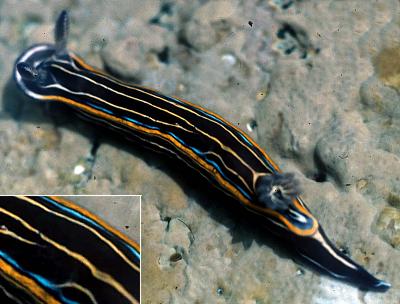
Hypselodoris villafranca
(Risso, 1818)
Order: NUDIBRANCHIA
Suborder: DORIDINA
Superfamily: EUDORIDOIDEA
Family: Chromodorididae
DISTRIBUTION
Mediterranean and Atlantic coasts from Britanny (France) to Morocco, Cape Verde Id, Canary Ids, Azores.
PHOTO
Angel Valdes - See his message.
Hypselodoris villafranca (Risso, 1818) is another dark blue chromodorid species with several dorsal yellow or white lines, but generally they form an irregular pattern, something like a broken network. In some small adults of H. villafranca, there may be three parallel lines as in H. picta, but this species is easily distinguished from H. picta by the greyish coloration of the gill and rhinophores and the presence of a white line on the rhinophores. Also, in H. villafranca the dorsal yellow lines form a circle around the branchial sheath.
Angel Valdes. [See his message].
Reference:
• Ortea, J., Valdés, A. & and García-Gómez, J.C. (1996) Revisión de las especies atlánticas de la familia Chromodorididae (Mollusca: Nudibranchia) de grupo cromático azul. [Review of the Atlantic species of the family Chromodorididae (Mollusca: Nudibranchia) of the blue chromatic group.] Avicennia, 1996, Suppl. 1: 1-165.
Valdes, A.., 2001 (January 24) Hypselodoris villafranca (Risso, 1818). [In] Sea Slug Forum. Australian Museum, Sydney. Available from http://www.seaslugforum.net/find/hypsvill
Related messages
Re: Hypselodoris gasconi? from the Adriatic
October 14, 2009
From: Marina Poddubetskaia Ossokine

Concerning message #16566:
Dear Bill,
I agree with your ID of the dorid [message #16566] : I also think it is a juvenile Hypselodoris villafranca. Here is an example of a juvenile of this species from French Mediterranean.
Locality: ' L'Estagnol ', Bormes-les-Mimosas?, 3 m, France, Mediterranean, 17 September 2009. Length: 6 mm. Photographer: Marina Poddubetskaia.
Best wishes,
Marina.
nembro@yahoo.fr
Poddubetskaia Ossokine, M., 2009 (Oct 14) Re: Hypselodoris gasconi? from the Adriatic. [Message in] Sea Slug Forum. Australian Museum, Sydney. Available from http://www.seaslugforum.net/find/22700Thanks Marina,
I'm glad to get some feedback
Best wishes,
Bill Rudman
Hypselodoris villafranca to be confirmed
May 19, 2007
From: Dominique Horst

Dear Bill,
This is a new chromodorid for me. I suppose it is Hypselodoris villafranca.
But as usual, the identification of the blue chromodorid is not so easy. More difficulties because the gill was in and I didn't wait enough to see the slug pushing it out.
Locality: Cap d'Antibes, 15m, France, Mediterranean sea, 26 December 2006, rocks. Length: 40mm. Photographer: Dominique Horst.
Many thanks and kind regards,
Dominique
dominique.horst@wanadoo.fr
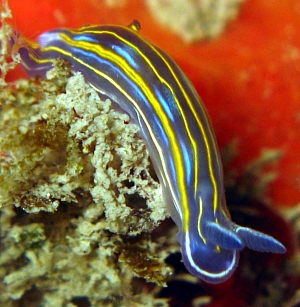

Dear Dominique,
With the usual proviso that I have no personal experience with Mediterranean 'blue chromodorids' I would agree that this is Hypselodoris villafranca.
Best wishes,
Bill Rudman
Mating Hypselodoris villafranca in Portugal
June 17, 2006
From: Joao Pedro Silva.

Dear Bill,
To accompany my photo of Hypselodoris cantabrica laying eggs [message #16873] here is a photo of Hypselodoris villafranca mating . Several dozen "cousins" of H. villafranca were mating that same day not far from H. cantabrica
Locality: Baleal, 7 meters, Portugal, Atlantic Ocean, 10 June 2006, rocky bottom. Photographer: Joao Pedro Tojal Loia Soares Silva.
Cheers,
Joao Pedro
jpsilva@uwphotographer.net
Silva, J.P., 2006 (Jun 17) Mating Hypselodoris villafranca in Portugal. [Message in] Sea Slug Forum. Australian Museum, Sydney. Available from http://www.seaslugforum.net/find/16878Dear Joao Pedro,
Thanks for this. If these animals are relatively common could I put in a request for a photo of the sponge they feed on and their egg ribbon? I am sure you have looked, but some more information on the biology of these animals is always welcome.
Best wishes,
Bill Rudman
Hypselodoris villafranca from Israel
June 2, 2006
From: Anat Lynn
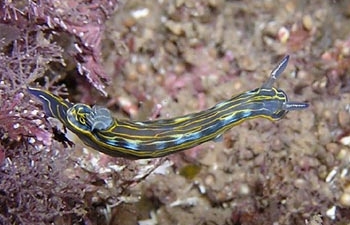
Concerning message #16334:
Is this Hypselodoris villafranca?
, ~5m, Israel, mediterranean sea, 29 April 2006. Length: ~3cm. Photographer: Anat Lynn.
Anat Lynn
ylynn@012.net.il
Lynn, A., 2006 (Jun 2) Hypselodoris villafranca from Israel. [Message in] Sea Slug Forum. Australian Museum, Sydney. Available from http://www.seaslugforum.net/find/16618Dear Anat,
Yes this is H. villafranca.
Best wishes,
Bill Rudman
Re: Yet another Hypselodoris from Portugal
May 8, 2006
From: David Abecasis
Concerning message #16516:
Hello again,
I also thought it would probably be a H. villafranca but it looks a bit different from the one I sent earlier [message #16334 ].
Thanks,
David Abecasis
davidbecas@netcabo.pt
Abecasis, D., 2006 (May 8) Re: Yet another Hypselodoris from Portugal. [Message in] Sea Slug Forum. Australian Museum, Sydney. Available from http://www.seaslugforum.net/find/16535Dear David,
I am glad to get your photos as it is helping to sort out - in my mind, and I hope others - just what variations occur in these blue chromodorid species. The two animals you have sent photos of recently do look rather different, but I understand that the white line up the back of each rhinophore club is quite distinctive. Looking at the literature, it seems the experts have been confusing themselves - and each other - for more than 100 years, so don't feel bad about being confused. I am certainly still hesitant about identifying them. What I am sure we need, is interested amateurs like you photographing them, and with luck finding what their egg ribbons look like, what they eat, what colour forms mate with each other, etc. It will take time, but I never ignore the opinions of local enthusiasts with a long-term knowledge of their local fauna. Often when we get to the dissection stage, subtle external differences, which have been noticed by amateur naturalists, match internal anatomical differences.
Best wishes,
Bill Rudman
Yet another Hypselodoris from Portugal
May 5, 2006
From: David Abecasis

Hello Bill,
I wonder if you or any expert from this side of the world can help me with the ID of this Hypselodoris.
Locality: Praia do Burgau, Lagos, 8 metres, Portugal, Atlantic Ocean, 30 April 2006, wreck in sandy bottom. Photographer: David Abecasis.
Many thanks,
David Abecasis
davidbecas@netcabo.pt


Dear David,
Hopefully I am gradually learning how to recognise these blue chromodorids. I am pretty sure this is Hypselodoris villafranca. The white lines on the gills and rhinophores are characteristic of that species. There should also be a yellow ring around the gill pocket we can't see if it is present in this photo because the gills are in the way.
Best wishes,
Bill Rudman
Re: Hypselodoris villafranca from Portugal
April 27, 2006
From: Juan Lucas Cervera
Concerning message #16334:
Hi Bill,
You're right.
Lucas.
lucas.cervera@uca.es
Cervera, J.L., 2006 (Apr 27) Re: Hypselodoris villafranca from Portugal. [Message in] Sea Slug Forum. Australian Museum, Sydney. Available from http://www.seaslugforum.net/find/16452Dear Lucas,
Glad to get one right!
Best wishes,
Bill Rudman
Hypselodoris villafranca from Portugal
April 24, 2006
From: David Abecasis

Hello Bill,
I have some problems identifying/distinguishing Hypselodoris. Anyway I'm not even sure if this specimen belongs to the Hypselodoris genus. Can you help me out?
Locality: Faro, 16 metres, Portugal, Atlantic Ocean, 13 April 2006. Photographer: David Abecasis.
Many thanks,
David Abecasis
davidbecas@netcabo.pt



Dear David,
These relatively high, elongate chromodorids with a narrow mantle skirt are almost certainly going to be a species of Hypselodoris. Unfortunately for you, your geographic region contains a group of species all with a very similar colour pattern. I am still trying to understand the differences so although they are usually a problem to identify, I welcome more photos of this colour group.
Having said that, I think this animal is H. villafranca, but I would welcome some feedback from local experts
Best wishes,
Bill Rudman
Hypselodoris villafranca from Portugal
August 5, 2005
From: Ana Rodrigues

Dear Bill
I' m a zoology teacher and I work with invertebrates (benthic ecology). One of the projects we are developing now is related to the biodiversity (animals and plants) of the northern Portuguese shores. We have found two sea slugs (20 mm - 30 mm) in tide pools with rocky bottoms at one of these beaches (Atlantic ocean). Using the sea slug forum (congratulations, it's a very good site) we have identified this one as Hypselodoris villafranca, but the other one which I have sent separately [see message #14467], I can't identify. The photos were taken by my colleague Victor Quintino.
Locality: Viana do Castelo (Praia do Norte), Portugal, tide pools - 1 m (intertidal). Length: 2-3 cm. 08 May 2005. tide pools - rocky bottom. Photographer: Victor Quintino
Thanks
Ana
anarod@bio.ua.pt
Rodrigues, A, 2005 (Aug 5) Hypselodoris villafranca from Portugal. [Message in] Sea Slug Forum. Australian Museum, Sydney. Available from http://www.seaslugforum.net/find/14470Dear Ana,
Thanks for the record, and good luck with your project. If you are going to have many pairs of eyes out looking at things, one very useful activity would be to look for animals 'doing things', such as laying eggs, feeding, mating etc. We know so little about the biology and natural history of even the most common animals, that noting and photographing such events is something valuable that someone with no knowledge can do.
Best wishes,
Bill Rudman
Adult Hypselodoris villafranca from France
August 4, 2003
From: Marina Poddubetskaia

Dear Bill,
A year ago I sent you photos of a juvenile Hypselodoris villafranca from Cerbere. Here is an adult from the same place to compare.
Date: July 08, 2003
Location: Cerbere, France, Mediterranean coast
Site: Cap Negre
Depth: 4m
Size : 20mm
Photos: Marina Poddubetskaia - Nembro website
Cheers,
Marina.
nembro@nembro.info
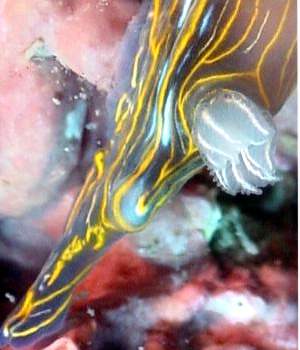
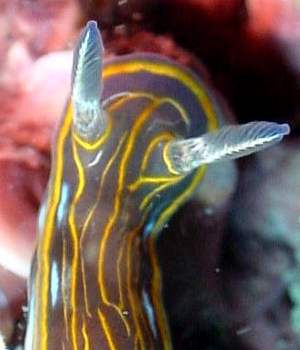
Thanks Marina,
Thes photos are very valuable in giving us a full picture of colour variation in this and the other similarly coloured Mmediterranean chromodorids
Bill Rudman
Hypselodoris villafranca from France
July 20, 2002
From: Marina Poddubetskaia


Dear Bill,
I have some difficulty in identifying this blue doris. I think, it is a juvenile of Hypselodoris villafranca. The side of the foot can't be seen very well but I noted that it had some thin white lines like in H. villafranca or H. fontandraui. Could you help me, please?
Location: Cerbere, France,[Mediterranean coast]. July 05, 2002
Site: La Ramere
Depth: 13m
Size: about 10mm
Photos: Marina Poddubetskaia - Nembro website
Best wishes,
Marina.
nembro@nembro.info
Poddubetskaia, M., 2002 (Jul 20) Hypselodoris villafranca from France. [Message in] Sea Slug Forum. Australian Museum, Sydney. Available from http://www.seaslugforum.net/find/7495Dear Marina,
This seems to fit Angel Valdes' comments on the Fact Sheet for H. villafranca so I think your tentative identification is probably correct.
Best wishes,
Bill Rudman
Blue chromodorid from Turkey
May 30, 2002
From: Baki Yokes


Dear Bill,
I know that you are interested in blue chromodorids from Mediterranean. Here is another specimen, which made me puzzled. What is your suggestion?
Date: 15/05/2002
Place: Antalya, Turkey
Divesite: Kemer
Depth: 2m, in a cavern
Size: 2-3cm
Photo: Levent Konuk leventkonuk@turk.net
Best wishes
Baki
bakiyokes@turk.net
Yokes, B., 2002 (May 30) Blue chromodorid from Turkey. [Message in] Sea Slug Forum. Australian Museum, Sydney. Available from http://www.seaslugforum.net/find/7069Dear Baki,
Please thank Levent for this interesting photo. You are right to feel hesistant about identifying blue chromodorids from the Mediterranean. At the risk of confusing you, I am pretty sure this is Hypselodoris villafranca which is characterised by the whitish line up the posterior edge of the rhinophore club and the yellow ring around the gill pocket.
There are many records of this species from Italy and the western Mediterranean, and along the Atlantic coast to Brittany. It has also been recorded from Israel so probably lives throughout the Mediterranean. I don't know of a previous record from Turkey.
Best wishes,
Bill Rudman
Hypselodoris villafranca from Spain
November 7, 2001
From: Luis Sánchez Tocino

Dear Dr. Rudman,
Here are some photos of Hypselodoris villafranca from the Mediterranean coast of Spain.
A: size - 20 mm , 23 January 1999, depth - 10m, Sponge: Dysidea fragilis, Punta del Vapor, (Almuñecar, Granada)
B: size - 20 mm, May 1998; depth - 7m, Cantarriján beach (Almuñecar,
Granada).
C: size - 25 mm, April 1996; depth -10m, La Rijana beach (Torrenueva,
Granada)
D: size 4mm, 6 October 1999, depth - 5 m (under stone), Piedra del Hombre,
(Bahía de la Herradura, Granada)
I have also sent some photos to show the detailed colour of the gills and rhinophores in a separate message.
Luis
lstocino@ugr.es


Thanks Luis,
I see from an earlier message of yours that juvenile H. picta can also have a white line replacing the yellow around the anterior and posterior mantle edge. Are they the only two of these Mediterranean species of Hypselodoris that do this?
Best wishes,
Bill Rudman
Hypselodoris villafranca from Spain (2)
November 7, 2001
From: Luis Sánchez Tocino

Dear Dr. Rudman,
Here are some close-up photos of the gills and rhinophores of Hypselodoris villafranca to accompany my other message.
These photos are of animals which were found on Dysidea fragilis at Cantarriján beach, Almuñecar, Granada, on the Mediterranean coast of Spain. Size - 10 mm, 31 October 2001, depth 8 m.
Luis
lstocino@ugr.es


Thanks Luis,
Bill Rudman.
